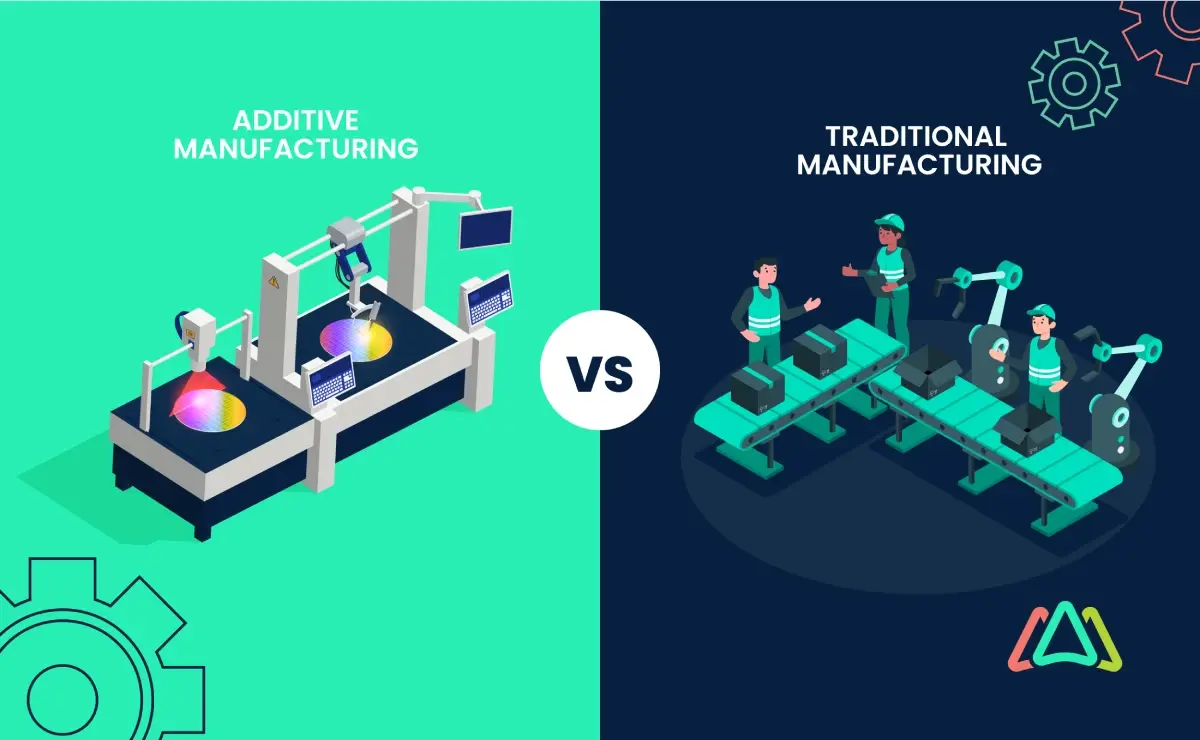
Additive Manufacturing vs. Traditional Manufacturing - A Comprehensive Comparison
Introduction
Improving manufacturing processes has become critical to reducing costs, increasing production efficiency, and driving innovation. Across various industries, businesses continuously seek ways to simplify processes, enhance product quality, and meet consumer demands. Effective manufacturing plays a vital role in achieving these objectives, making the selection of the right manufacturing approach more important than ever. The purpose of this article is to provide a comprehensive comparison between two manufacturing processes: Traditional Manufacturing and Additive Manufacturing. By examining their strengths, limitations, and potential synergies, you will gain a deeper understanding of how each approach can be leveraged to meet specific production needs and how the integration of both methods can optimize manufacturing efficiency.
What is Traditional Manufacturing?
Traditional Manufacturing encompasses a range of subtractive processes where the material is systematically removed from a larger block or workpiece to create the desired final product. This approach has been foundational to industrial production for decades, involving several well-established techniques.

Common Techniques
Machining:
This includes high-precision processes such as drilling, milling, and turning. While machining allows for detailed and accurate shaping, it often generates significant material waste as excess material is cut away to achieve the final form.
Injection Molding:
Widely used for mass production, especially with thermoplastics, this technique involves injecting molten material into molds to form objects. It is highly efficient for creating large quantities of identical parts with consistent quality.
Forming:
This process involves shaping heated materials into thin, hollow objects. It is commonly used in the production of packaging materials and other lightweight components.
Joining:
This technique involves combining separate components through methods such as welding, fastening, or adhesive bonding. Good for assembling complex structures and achieving the desired final configurations.
These traditional manufacturing techniques have long been integral to the production industry, providing the precision, reliability, and scalability needed for various applications.
What is Additive Manufacturing?
Additive Manufacturing (AM) is a transformative technology that creates objects layer by layer by adding material, commonly known as 3D printing. Unlike traditional manufacturing methods that subtract material from a solid block, AM constructs items from the ground up, enabling the creation of complex designs with minimal material waste. This approach not only allows for the production of complex geometries and internal structures but also offers significant material efficiency, as only the material necessary for the object is used.

Common Techniques
Powder Bed Fusion (PBF):
This technique involves melting powder materials using a laser or electron beam to fuse the powder particles into solid layers. It is widely used to create complex metal and plastic parts with high precision.
Material Extrusion:
In this method, polymer material is extruded through a heated nozzle to build objects layer by layer. It is a popular technique for producing plastic prototypes and end-use parts.
Directed Energy Deposition (DED):
This process uses focused energy, such as a laser or electron beam, to melt feedstock material, which is then deposited onto a substrate to build up the object. It is commonly used for repairing and adding material to existing components.
Sheet Lamination:
This technique involves stacking and bonding thin sheets of material, which are then cut into the desired shape to create layered objects. It is suitable for producing large parts with relatively low resolution.
Binder Jetting:
Binder jetting uses a binding agent to selectively bind powder materials, layer by layer, to form solid objects. It is known for its fast build speeds and ability to work with a variety of materials, including metals and ceramics.
Selective Laser Sintering (SLS):
This process employs a high-power laser to sinter polymer particles into a solid form. It is valued for its ability to produce strong and durable parts with complex geometries.
Vat Photopolymerization:
In Vat photopolymerization, a UV light cures liquid photopolymer resin, layer by layer, to create highly detailed and accurate objects. This method is often used for high-resolution prototypes and complex models.
These diverse techniques highlight the flexibility and precision of Additive Manufacturing, making it a versatile tool across various applications and industries.
Differences Between Traditional and Additive Manufacturing

|
Aspect |
Traditional Manufacturing |
Additive Manufacturing |
|---|---|---|
|
Physical Characteristics |
Subtractive process (removes material from a workpiece). Strong, durable parts with established techniques. |
Additive process (builds layer by layer). Parts can be strong but may not always match traditional methods in durability. |
|
Production of Complex Geometries |
Complex designs are constrained by Design for Manufacturing (DFM) rules, requiring simplification for manufacturability. |
Freedom to create complex geometries, reducing the need for DFM rules. Supports complex shapes without the need for assembly. |
|
Assemblies |
Parts are typically manufactured separately and assembled afterward, requiring additional tools and time. |
Can print assemblies as a single piece, reducing the need for post-production assembly and minimizing errors. |
|
Sustainability |
AM is more sustainable as it produces less material waste, using only the material required to build the part layer by layer. It also enables localized production, reducing transportation emissions. |
Traditional manufacturing typically generates more waste through subtractive methods like machining and excess material use, especially in high-volume production. |
|
Custom Designs |
Customization is limited due to tooling requirements and high costs. Producing unique designs can be expensive. |
Allows for easy customization and unique designs at lower costs, making it ideal for one-off or small-batch production. |
|
Manufacturing Equipment |
Multiple tools and machines are required for different processes, such as milling, turning, drilling, and forming. |
A single 3D printer can produce a wide range of parts, reducing the need for multiple machines or tools. |
|
Material Selection |
A broader range of materials is available, including metals, plastics, and composites, offering flexibility. |
Limited material selection based on specific additive techniques (e.g., polymers, metals, or ceramics). |
|
Production Quantity |
Suited for high-volume production, making it cost-effective for mass manufacturing. |
Best for low-volume production or custom parts. Costs rise significantly with high-volume runs due to time and material usage. |
|
Lead Time and Production Costs |
Longer lead times due to tooling, setup, and production processes. High cost for smaller production runs but becomes economical with scale. |
Shorter lead times with quicker turnaround for small-batch or custom parts. Lower cost for short runs due to no tooling. |
How Additive Manufacturing Complements Traditional Manufacturing
Additive manufacturing (AM) offers several ways to complement traditional manufacturing, enhancing overall production efficiency and capabilities.

Fast Prototyping
Additive manufacturing significantly accelerates the prototyping phase of product development. Traditional manufacturing methods, such as machining or injection molding, often involve lengthy setup times and high costs for creating prototypes. In contrast, 3D printing enables rapid prototyping by producing parts directly from digital models without the need for specialized tooling. This speed allows design teams to quickly iterate on designs, test functionality, and make adjustments before committing to mass production. By reducing the time and expense associated with prototyping, AM helps companies reduce production times by up to 50%.
Enhanced Tooling
One of the significant advantages of AM is its ability to produce more complex and efficient tooling, such as injection molds with conformal cooling channels. These channels optimize the cooling process, reducing cycle times and improving the quality of final products. By integrating 3D printing into the tooling phase, manufacturers can achieve greater productivity and enhanced product performance, making it a valuable complement to traditional methods.
Flexible Manufacturing Capacity
Additive manufacturing provides exceptional flexibility in production capacity. Traditional manufacturing methods may require significant retooling or adjustments to scale production up or down based on demand. In contrast, additive techniques allow for scalable production without the need for extensive changes to equipment or processes. This flexibility is particularly valuable in industries where demand can fluctuate rapidly, such as aerospace or consumer goods. AM enables manufacturers to quickly adjust production volumes, making it possible to respond more effectively to market changes and customer needs.
Hybrid Processes
Combining additive and traditional manufacturing techniques, known as hybrid processes, can yield significant benefits. For instance, precision parts can be initially 3D-printed to create complex geometries, which are then refined through traditional machining processes. This hybrid approach leverages the strengths of both methods, the design freedom and material efficiency of AM, with the precision and finishing capabilities of traditional manufacturing. By integrating these processes, manufacturers can achieve high-quality components that meet any specifications while also benefiting from reduced production times and costs.
Additive manufacturing complements traditional manufacturing by enhancing prototyping speed, enabling part consolidation, providing flexible production capacity, and facilitating hybrid processes. By leveraging the strengths of both approaches, manufacturers can achieve greater efficiency, cost savings, and innovation in their production processes.
Conclusion
Traditional and additive manufacturing each offer unique strengths; traditional methods excel in high-volume production and material variety, while additive manufacturing shines in rapid prototyping, complex geometries, and customization. Companies can maximize their production efficiency and flexibility by integrating both approaches. Utilizing traditional manufacturing for bulk production and additive techniques for prototyping and complex parts allows for a more adaptable and efficient manufacturing process. Embracing both technologies can drive innovation and operational excellence.
TABLE OF CONTENTS
Keep Reading
Asset lifespan is a key concern for executives and maintenance and facility management teams. ...
3 Jul 2025
Your company recently invested funds and time for new CMMS software, and six months later, it ...
1 Jul 2025
As Computerized Maintenance Management Systems (CMMS) become more connected and cloud-based, ...
1 Jul 2025
Edge computing is an innovative technology that enables data to be processed at the source, ...
24 Jun 2025
Facility management has undergone a significant transformation in recent times. Take, for ...
20 Jun 2025
A facility maintenance plan is at the core of a facility’s operations. This organized ...
19 Jun 2025
In the early days, preventive maintenance could be done effectively with a trained eye and a ...
17 Jun 2025
Sticky notes fall off, whiteboard grids get wiped, and spreadsheets never beep when a ...
13 Jun 2025
Handing a slice of your maintenance workload to a contractor is less about “giving up ...
12 Jun 2025
Downtime in enterprise environments doesn’t just mean a stop in operations; it means lost ...
10 Jun 2025
Understanding equipment functionality is crucial for effective repairs. A clear, systematic ...
6 Jun 2025
Maintenance managers know that every unplanned equipment failure is more than a simple ...
5 Jun 2025
What keeps a facility running smoothly? Initially, many of us may zoom in on its equipment, ...
29 May 2025
In today's digital world, every decision needs to pass the test of strategic and operational ...
27 May 2025
The business world is very different from a decade ago. Technological advancements have grown ...
23 May 2025
Picture this: a maintenance technician inspects a complex pump system. Instead of typing a ...
20 May 2025
For most of the 20th century, maintenance teams mainly applied a reactive approach to ...
9 May 2025
Imagine visiting a manufacturing plant where maintenance technicians gather around a large ...
8 May 2025
Maintenance management faces complexities across all industries, escalating with ...
6 May 2025
Ever find yourself checking into a luxury hotel and expecting a relaxing stay, only to find a ...
11 Apr 2025





